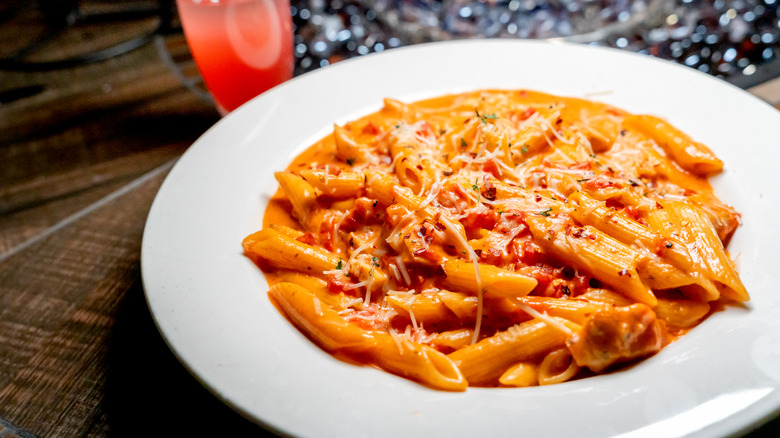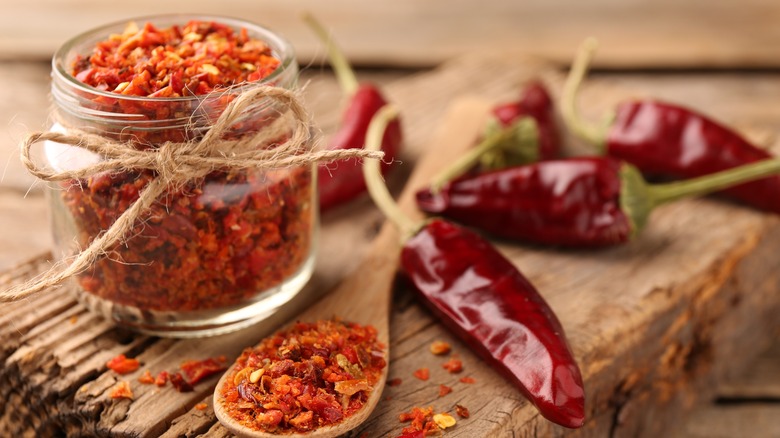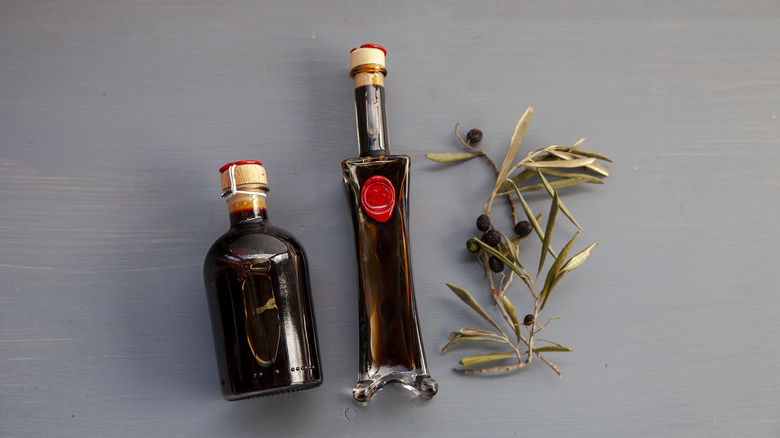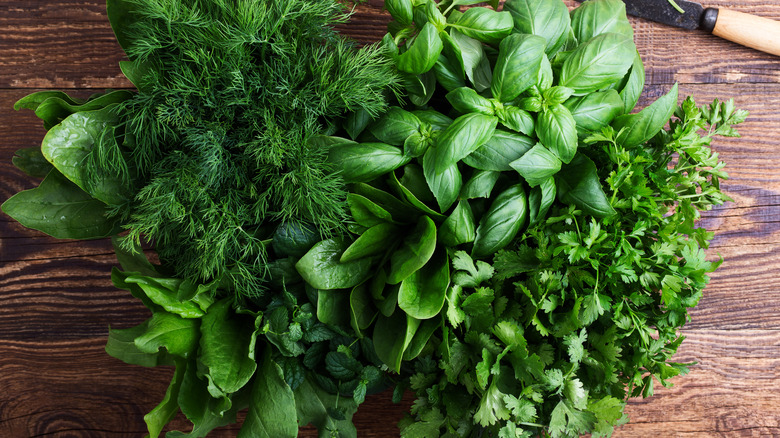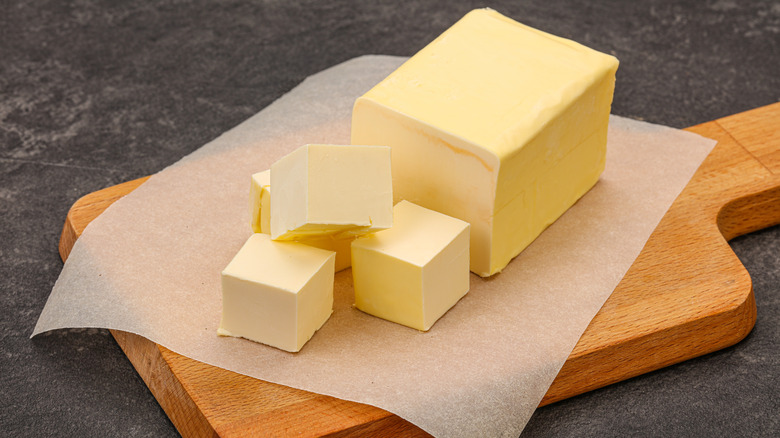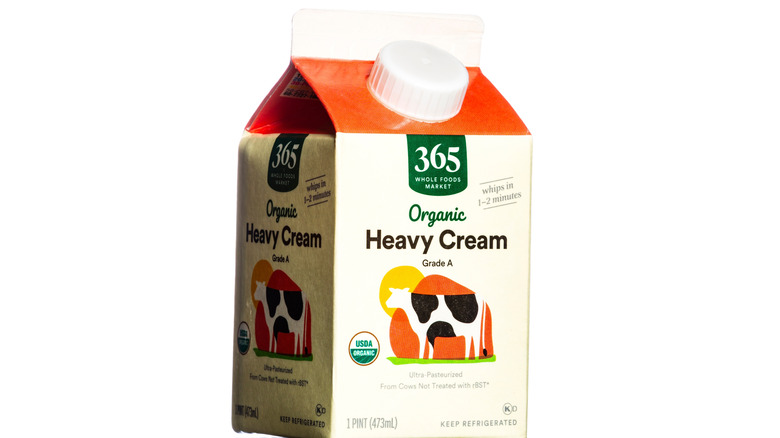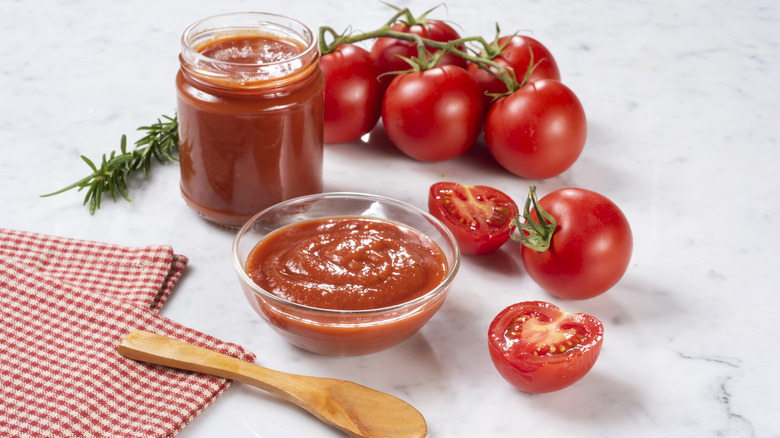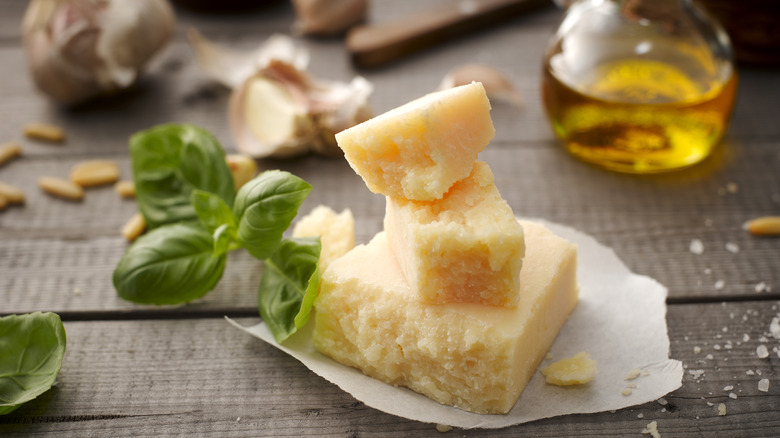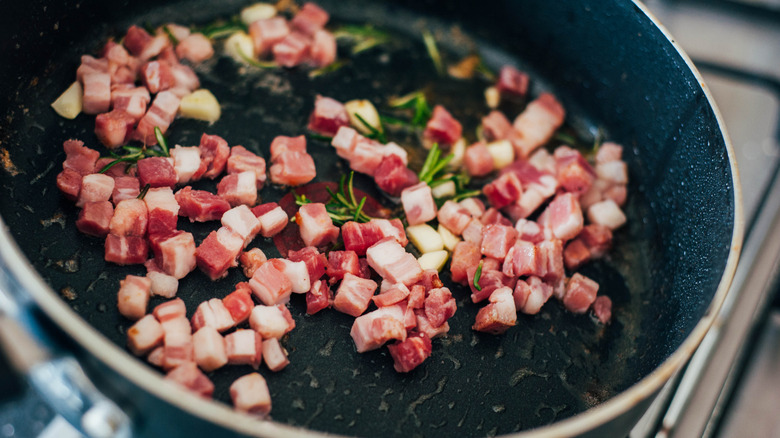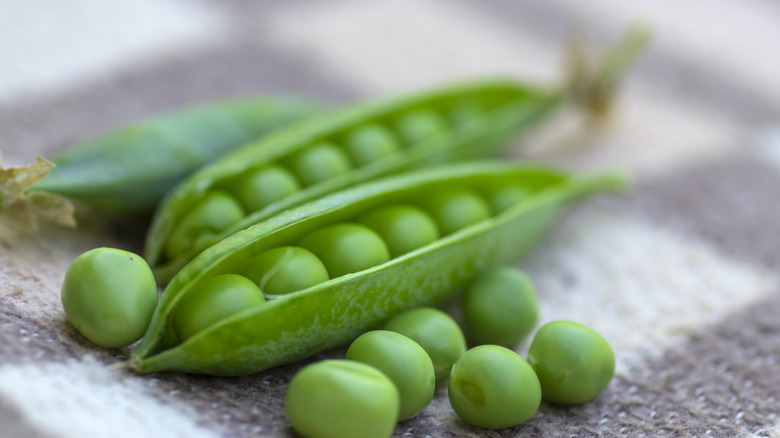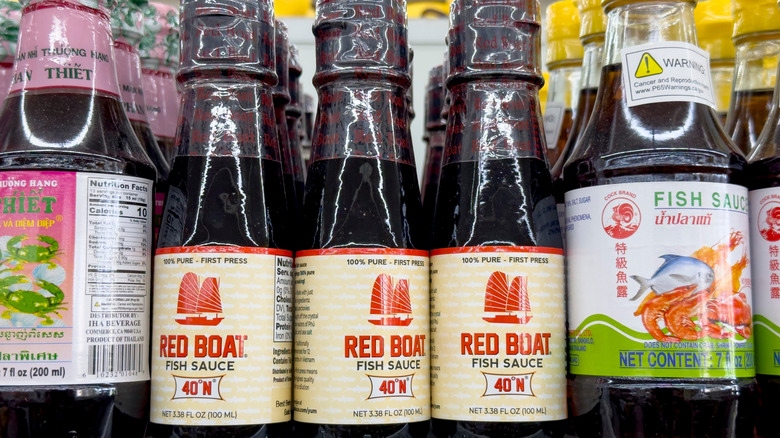Chefs Share 10 Simple Ingredients To Upgrade Store-Bought Vodka Sauce
If you have dined in an Italian restaurant, chances are you have spotted the popular penne alla vodka on the menu. Also known as "pink sauce" due to its reddish-pink color, this sauce combines tomato with heavy cream for a perfect balance of acid and richness — as if you had all the positives of marinara and alfredo sauces wrapped in a pretty pink hue. The flavor boost is amplified by adding in a small amount of vodka (not to worry, it is safe for the kiddos, as the alcohol burns off to a minimal amount) to emulsify the tomatoes and cream. What's left behind is a hint of the vodka's flavor and aroma to balance the sauce.
Vodka sauce has continued to grow in popularity, with Gigi Hadid's vodka sauce going viral a few years ago. Though there are many recipes that boast an easy vodka sauce, you may not have all the ingredients on hand, or the time to prep one from scratch. This may lead you to grab a store-bought jar of vodka sauce, and there are many delicious options to choose from. But it may be worth the extra effort to make a couple little tweaks to your store-bought sauce to elevate it even more. We've consulted some of the experts to get their top tips for taking your vodka sauce to the next level.
Red pepper flakes or chilies
A big benefit of making your own sauce from scratch is being able to control the spice level. While many palates prefer a sauce with a little kick, you may find that jarred sauces tend to be a little on the safe side in regards to spice. Dried red pepper flakes are a staple pantry item (especially for pizza lovers) and can kick up that heat level to offset the creaminess with minimal effort. Red pepper flakes are easy to find in the grocery store and are pretty cost-effective. Aleppo pepper, commonly used in Turkish or Mediterranean cuisine, can be another substitute.
If you really want to add some heat, try Calabrian chili paste, a specialty from Southern Italy. This paste is typically made from peppers grown and harvested in Italy that are crushed and jarred with olive oil. These are just two of the common options that can increase the spiciness of your sauce. However, some note that the flavors really meld together when these spices are heated beforehand in oil. You may find it worth the time to start with your chilies or flakes in oil first, then add the sauce to be warmed in the pan. Heating up your jarred sauce on the stovetop instead of adding at room temperature to your pasta is generally a good idea so that you get the full flavor profile.
Balsamic vinegar or lemon juice
One thing you may notice about jarred sauces is that they can be one-note in terms of flavor. Depending on the brand, some sauces can taste sweeter than others — and people won't hold back in their reviews like the Trader Joe's vodka sauce that divided devoted TJ fans. That may be a sign that the store-bought variety is lacking the acidity we love in tomato-based sauces, which experts say is not an uncommon occurrence. "Acid in jarred vodka sauce never translates because it has to be shelf stable," says Matt Harding, Chief Concept Officer at Piada Italian Street Food. "Adding a fresh lemon juice or a splash of balsamic vinegar at the end of the cooking time will brighten the sauce, giving it a more balanced flavor and fresher taste."
A benefit of balsamic vinegar is the vinegar's sweet, acidic notes, according to Shawn Matijevich, lead chef-instructor of Online Culinary Arts & Food Operations at the Institute of Culinary Education. However, Matijevich says lemon zest can bring some brightness and freshness to your dish. "Adding extra ingredients to a store-bought sauce allows you to customize it to your own preferences," he says. "The finished sauce may feel homemade and elevated without having to make it from scratch."
Herbs and aromatics
If you're worried about your jarred sauces lacking flavor, simply adding some more dried or fresh herbs can liven up your sauce. "Adding fresh herbs is a great way to customize your sauce and create a marriage of flavors," says Matt Harding. The options are endless, with oregano, basil, thyme, tarragon and parsley being popular choices to add to jarred sauce. Harding says rosemary and thyme are two of his favorites in addition to adding aromatics, as well as smoked paprika, which provides depth and a flavor-boost. "Adding extra onion, shallot, or garlic to cook in the sauce, and bring a bit of bite that will have been processed out of the aromatics used in the original sauce," he adds.
Shawn Matijevich's preferred herb additions to vodka sauce are fresh basil and oregano, but he echoed the use of garlic. He also noted that these additions can add a layer of complexity to your previously one-note jarred sauce. However, there are slight differences in taste between fresh garlic or roasted garlic that you may want to consider. "Fresh garlic adds a bold, aromatic kick, whereas roasted garlic contributes a sweeter, mellow depth that pairs well with the creaminess of the sauce," he says. If you are in a pinch and don't have fresh garlic on hand, garlic powder can be a substitute. But be aware that while garlic powder is convenient and a time-saver, the flavor may be more mild than the fresh alternative.
Butter
Vodka sauce typically isn't one that you want to count calories for thanks to the heavy cream. But it is a necessity to the rich deliciousness of the sauce, especially when it is homemade. However, when you buy jarred sauce, you may find that it is lacking in richness. Butter is an ingredient that can be added to a store-bought sauce to enhance the sauce with its creamy, delicate flavor. "Adding a knob of butter at the end (probably more than you think is appropriate) as a great way to pump up the sauce. It enrichens the flavor and adds a touch of elegance to the sauce," says Matt Harding.
Butter has long been a "secret ingredient" for many aspiring cooks. It is a key ingredient in tomato sauces like Italian chef Marcella Hazan's iconic four-ingredient tomato sauce (tomatoes, onions, butter, and salt). Butter can balance the heavy acidity sauces can have from tomatoes. Another bonus for adding butter in your sauce is that it can help keep the texture silky. A good sauce should coat the pasta evenly and cling to it. You may find the texture in jarred sauce can vary, so adding a little butter can remedy any consistency issues.
Cream
One of the unique qualities of vodka sauce is that you don't have to choose between a cream sauce or a tomato sauce — it is both in one dish. If you find your storebought sauce is lacking in the richness department, Shawn Matijevich suggests adding even more heavy cream or half-and-half for an extra rich sauce. "Heavy cream or half-and-half can make the sauce richer and silkier," he says. Like adding butter to your jarred sauce, cream can streamline the consistency and improve texture.
While you can use half-and-half and heavy cream relatively interchangeably (with the exception of some desserts), it is worth noting the heavy cream will add more richness to your dish than half-and-half. This is because half-and-half has less milkfat content than heavy cream. The less fat in half-and-half makes it a lower-calorie option than heavy cream, which may make it an appealing choice to some. Heavy cream also has a thicker consistency than half-and-half, so it is something to be aware of when modifying your sauce. Whole milk can be a substitute if necessary, but the consistency will be thinner (likely more so than using half-and-half).
Tomato paste
While tomato is one of the main ingredients in vodka sauce, sometimes the flavor can be lacking in the store-bought variety. It could be because the tomatoes used weren't as flavorful as what you would use when making your own vodka sauce at home, or that the proportion of tomato to cream is slightly off. To get more of that sweet and acidic tomato flavor without adding too much additional liquid, try tomato paste. This paste is made out of concentrated tomatoes along with salt, sugar or herbs, and is sold in small jar or tube quantities. Tomato paste can act as a savory flavor boost and a thickening agent if your sauce is too runny. A little bit can go far, so start with just a tablespoon and stir it into your jarred sauce heating on the stovetop. You can increase the amount of tomato paste in your sauce as needed.
Tomatoes in a different preparation can also yield similar results for flavors. Shawn Matijevich suggests adding sun-dried tomatoes to store-bought sauces, as they can "deepen the sauce's tomato flavor." Sun-dried tomatoes are pantry-stable, as they are packed in oil to preserve their tangy flavor. They were traditionally made from red plum tomatoes, but can also be found in red or yellow varieties. Another bonus, you can also use the oil of sun-dried tomatoes as an olive oil substitute for a flavor punch.
Cheese
Cheese is an ingredient that many of us can't get enough of in Italian cooking. So if all else fails and you think your store-bought vodka sauce is lacking, cheese can add some much-needed flavor and tastiness. "Using a high quality cheese to finish the sauce also adds another layer of flavor to the sauce," says Matt Harding. "Cheeses like Pecorino Romano, made from sheep's' milk adds a touch of twang and saltiness."
Shawn Matijevich's cheese preference for vodka sauce is Parmesan. "Freshly grated Parmesan cheese will add a nutty, umami flavor that enhances the sauce's taste," he says, adding that cheese will also help keep the sauce's texture smooth. Melting more parmesan cheese can also help your sauce thicken up if it has become too runny. And if you are a cheese fanatic, some recipes suggest serving your penne alla vodka with a whole or half ball of mozzarella or burrata cheese. Otherwise, finishing your penne alla vodka with grated Parmesan or Pecorino Romano can be both tasty and visually appealing.
Protein
This option wouldn't be the first choice for those on a vegetarian diet. Store-bought vodka sauces can be as simple as its three main ingredients: tomatoes, cream and vodka (give or take some aromatics depending on the brand). However, your jarred vodka sauce may benefit from the flavors of cooking down some protein — specifically pork. Italian food brand DeLallo suggests starting homemade vodka sauce by cooking pancetta and onions in a pan with olive oil until caramelization, so why not give your store-bought sauce the same treatment?
Another option for protein is prosciutto — an aged, dry-cured ham commonly used in Italian cooking. "One of my favorite additions is adding torn pieces of prosciutto to the sauce right before serving," says Melissa Oleary of Keeping it Simple Italian. "The idea is to not cook the prosciutto since you want it to stay soft and tender. It adds a beautiful fresh salty bite to the pasta and really elevates vodka sauce."
Vegetables
A more vegetarian-friendly option to elevate your vodka sauce is to add some vegetables to the mix. Using vegetables brings in some fun, bright colors that can be appealing with vodka sauce's already pink hue, as well as some notes of sweetness. Melissa Oleary says some fresh or frozen peas can work wonders for adding a slightly sweet note to your sauce to balance out any inherent saltiness. "By adding these fresh ingredients to store-bought sauce, it wakes up the flavors of the sauce, which store bought sauce often needs," she says. Oleary suggests adding your peas into your vodka sauce on simmer for a couple of minutes before serving to catch those fresh, sweet pops of flavor.
If you want your dish to more vegetable-forward, you can roast seasonal vegetables of your choice and serve them with your vodka sauce and pasta. Some popular choices include peppers, zucchini or cherry tomatoes.
Fish sauce
Fish sauce is known as the star ingredient of Thai or Southeastern Asian dishes but you don't necessarily hear about it as often in Italian cooking. Fish sauce's ability to add salty and savory notes with a slight sweetness makes it a key ingredient, with flavor profile similarities in umami boosters like Parmesan cheese or Worcestershire sauce. For this reason, Matt Harding says a dash of fish sauce in your vodka sauce can be a positive (and unexpected) addition. "Adding a touch — and when I say touch I mean start with a small amount — of fish sauce with a brand like Red Boat is a great addition if you are adding seafood to the sauce," he says.
If utilizing seafood doesn't bother you, some recipes even suggest adding anchovies to your vodka sauce for a unique flavor. It's not too much of a stretch as fish sauce is made from fermented anchovies. Anchovies are also considered a staple in Italian cooking, so with this addition you can lean into the authentic flavors of southern Italy's Amalfi coast.
